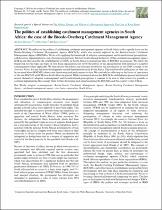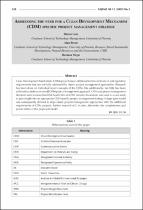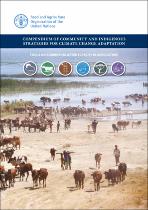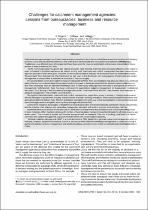 ResearchSpace
ResearchSpace
The politics of establishing catchment management agencies in South Africa: the case of the Breede-Overberg catchment management agency
JavaScript is disabled for your browser. Some features of this site may not work without it.
- ResearchSpace
- →
- Research Publications/Outputs
- →
- Journal Articles
- →
- View Item
| dc.contributor.author |
Meissner, Richard

|
|
| dc.contributor.author |
Funke, Nicola S

|
|
| dc.contributor.author |
Nortje, Karen

|
|
| dc.date.accessioned | 2017-02-03T10:48:32Z | |
| dc.date.available | 2017-02-03T10:48:32Z | |
| dc.date.issued | 2016 | |
| dc.identifier.citation | Meissner, R., Funke, N. and Nortje, K. 2016. The politics of establishing catchment management agencies in South Africa: the case of the Breede-Overberg catchment management agency. Ecology and Society, 21(3):26 | en_US |
| dc.identifier.issn | 1708-3087 | |
| dc.identifier.uri | https://www.google.co.za/url?sa=t&rct=j&q=&esrc=s&source=web&cd=1&cad=rja&uact=8&ved=0ahUKEwjqx-rU3vPRAhXmBsAKHaDfAMUQFggaMAA&url=http%3A%2F%2Fwww.ecologyandsociety.org%2Fvol21%2Fiss3%2Fart26%2FES-2016-8417.pdf&usg=AFQjCNHWcojDAXEViIrjBlIUXb_lmbp9KA&sig2=e_Gf7G3k1G_3lHBOcYgnmg | |
| dc.identifier.uri | http://hdl.handle.net/10204/8934 | |
| dc.description | Copyright: 2016 Resilience Alliance | en_US |
| dc.description.abstract | We reflect on the politics of establishing catchment management agencies in South Africa with a specific focus on the Breede-Overberg Catchment Management Agency (BOCMA), which was recently replaced by the Breede-Gouritz Catchment Management Agency (BGCMA). We do so by applying the framework of adaptive comanagement and its institutional prescriptions: collaboration, experimentation, and a bioregional approach. We start by introducing the history of this catchment management agency (CMA) and then describe the establishment of CMAs in South Africa in general and that of BOCMA in particular. We follow the framework for rule types and types of river basin organizations set out by the editors of this special feature with reference to adaptive comanagement where applicable. We then discuss the politics and strategies involved in the introduction of the CMA concept to the National Water Act and the latest developments around these institutions in South Africa. This is followed by reflections on what can be surmised about BOCMA’s democratic functioning and performance to date. We conclude by reflecting on the future of operations of the new BGCMA and CMAs in South Africa in general. While our research shows that BOCMA’s establishment process has featured several elements of adaptive comanagement and its institutional prescriptions, it remains to be seen to what extent it is possible to continue implementing this concept when further developing and operationalizing the BGCMA and the country’s other CMAs. | en_US |
| dc.language.iso | en | en_US |
| dc.publisher | Resilience Alliance | en_US |
| dc.relation.ispartofseries | Wokflow;17568 | |
| dc.subject | Adaptive co-management | en_US |
| dc.subject | Breede-Overberg catchment management agency | en_US |
| dc.subject | Breede-Gouritz catchment management agency | en_US |
| dc.subject | River basin organization | en_US |
| dc.title | The politics of establishing catchment management agencies in South Africa: the case of the Breede-Overberg catchment management agency | en_US |
| dc.type | Article | en_US |
| dc.identifier.apacitation | Meissner, R., Funke, N. S., & Nortje, K. (2016). The politics of establishing catchment management agencies in South Africa: the case of the Breede-Overberg catchment management agency. http://hdl.handle.net/10204/8934 | en_ZA |
| dc.identifier.chicagocitation | Meissner, Richard, Nicola S Funke, and Karen Nortje "The politics of establishing catchment management agencies in South Africa: the case of the Breede-Overberg catchment management agency." (2016) http://hdl.handle.net/10204/8934 | en_ZA |
| dc.identifier.vancouvercitation | Meissner R, Funke NS, Nortje K. The politics of establishing catchment management agencies in South Africa: the case of the Breede-Overberg catchment management agency. 2016; http://hdl.handle.net/10204/8934. | en_ZA |
| dc.identifier.ris | TY - Article AU - Meissner, Richard AU - Funke, Nicola S AU - Nortje, Karen AB - We reflect on the politics of establishing catchment management agencies in South Africa with a specific focus on the Breede-Overberg Catchment Management Agency (BOCMA), which was recently replaced by the Breede-Gouritz Catchment Management Agency (BGCMA). We do so by applying the framework of adaptive comanagement and its institutional prescriptions: collaboration, experimentation, and a bioregional approach. We start by introducing the history of this catchment management agency (CMA) and then describe the establishment of CMAs in South Africa in general and that of BOCMA in particular. We follow the framework for rule types and types of river basin organizations set out by the editors of this special feature with reference to adaptive comanagement where applicable. We then discuss the politics and strategies involved in the introduction of the CMA concept to the National Water Act and the latest developments around these institutions in South Africa. This is followed by reflections on what can be surmised about BOCMA’s democratic functioning and performance to date. We conclude by reflecting on the future of operations of the new BGCMA and CMAs in South Africa in general. While our research shows that BOCMA’s establishment process has featured several elements of adaptive comanagement and its institutional prescriptions, it remains to be seen to what extent it is possible to continue implementing this concept when further developing and operationalizing the BGCMA and the country’s other CMAs. DA - 2016 DB - ResearchSpace DP - CSIR KW - Adaptive co-management KW - Breede-Overberg catchment management agency KW - Breede-Gouritz catchment management agency KW - River basin organization LK - https://researchspace.csir.co.za PY - 2016 SM - 1708-3087 T1 - The politics of establishing catchment management agencies in South Africa: the case of the Breede-Overberg catchment management agency TI - The politics of establishing catchment management agencies in South Africa: the case of the Breede-Overberg catchment management agency UR - http://hdl.handle.net/10204/8934 ER - | en_ZA |








